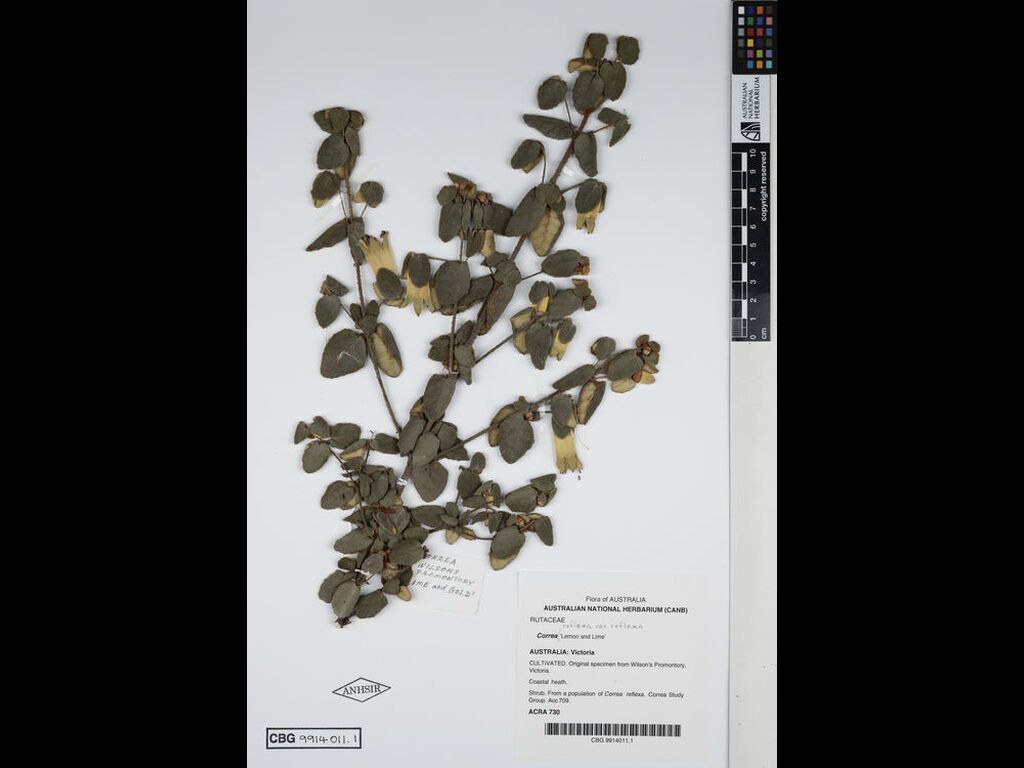Correa reflexa var. reflexa 'Lemon and Lime'
- File Number
- 709
- ACRA Field Book Number
- 730
- Registration Date
- 01/09/1999
- Application Received
- 17/06/1999
- Family
- Rutaceae
- Cultivar Name
- Correa reflexa var. reflexa 'Lemon and Lime'
- Origin
- Correa 'Lemon and Lime' is a selection from a wild population of Correa reflexa from coastal heath-land at Wilson's Promontory, Victoria. The name refers to the area where it was found and the colour of the flowers. The originator is unknown but it was found in 1990..
- Characteristics
- Note: Received as Correa 'Wilson's Promontory Lime and Gold' Low growing shrub to ca. 60 cm x 2 m with a dense habit. Branchlets highly tomentose with rust coloured stellate hairs becoming brown and glabrous with age. Simple cordate leaves, 30 mm x 24 nun, shortly petiolate. Leaf apices obtuse, leaf bases cordate, venation reticulate, entire margins with rust-coloured stellate hairs. Upper surfaces of mature leaves dark green and scabridulous with scattered white stellate hairs becoming more concentrated at margins. Upper surfaces of young leaves densely tomentose with rust-coloured stellate hairs. Young growth may have pink tinge. Lower surfaces of leaves densely tomentose with white stellate hairs and scattered rust-coloured stellate hairs becoming more concentrated on the veins and margins. Foliaceous bracts strongly reflexed to enclose flower. Peduncles axillary, slender, terminating in a pair of foliaceous bracts clasping the flower. Calyx hemispherical, 4 mm high, fawn coloured with scattered rust-coloured stellate hairs. Corolla obconical 32 mm x 12 mm, lemon with lime green tips covered with fine tomentum of white-coloured stellate hairs becoming rusty at tips. Anthers shortly exerted, narrow oblong and obtuse. Peak flowering is from March to July in most districts. Diagnosis: This cultivar conforms to descriptions for C. reflexa var. reflexa found naturally in the Gippsland area but is distinctive by its unique flower colour. The usual green form of C. reflexa is uniformly coloured from calyx to tip.
- Cultivation
- This low-growing cultivar is frost and drought hardy and has a dense growth habit with ascending branches. The large yellow and green flowers, which appear in autumn, are an attractive feature of the plant. It is easy to grow from cuttings and is bird attractive. This form would be suited to most garden conditions but prefers an open sunny position for maximum flowering. It responds favourably to light pruning. It would suit tub planting, embankments and rockeries as well as foreground planting in garden beds but requires protection from strong, winds. It has been trialed for over 8 years and is available commercially.
- Publication
- Hitchcock, M. (2003), Descriptions of the Species, Varieties and Cultivars. Australian Plants 22(174): 35
- Colour Coding
- RHS Colour Chart 1995 Corolla tube:1D to 1CCorolla lobes: Close to 144A/B* Leaves upper surface:close to 147A, new growth close to 137A Leaves lower surface:193A
- Propagation
- Cuttings from semi-firm new growth
- Applicant Name
- Cherree Densley on behalf of the ASGAP Correa Study Group. Specimen firstreceived by the Authority 17th June 1999.
- Uses
- As part of a mass planting or mixed in a shrubbery, or as a feature plant. Attracts nectar feeding birds.
- Availability
- Specialist native plant nurseries
- ANBG Accession Numbers
- ACC709, ACRA730, CBG9914011
- NSL ID
- -

